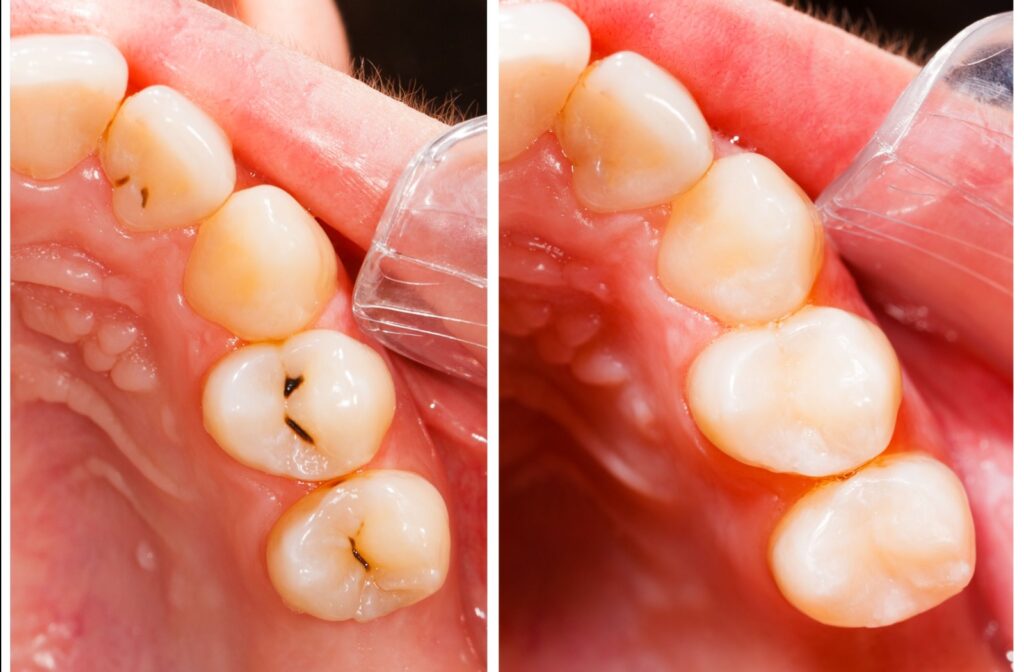Cavities can be uncomfortable, but they can also easily be fixed. If left untreated, however, they can have consequences to your oral health.
Understanding the process of cavity treatment can relieve some of the anxiety that sometimes accompanies a dental visit. The time it takes to fill a cavity can vary depending on several factors, including its size, depth, location, type of filling material used, and your dentist’s protocols. On average, it typically takes between 30 minutes to an hour to fill a cavity.
In this post, we’ll explain everything you need to know about how long it takes to fill a cavity and what factors might influence the timing.
What Is a Cavity?
A cavity is a defect in the tooth enamel and/or dentin that develops due to tooth decay. This decay occurs when bacteria in dental plaque interact with sugars in the food you eat. Over time, tooth decay can lead to significant damage to a tooth.
Why Cavities Are Harmful
If left untreated, cavities can lead to serious oral health problems. Initially, tooth decay may not cause any noticeable symptoms, which makes it easy for cavities to grow undetected.
As the decay progresses, however, it penetrates deeper into the tooth structure. If the decay reaches the pulp chamber, which contains nerves and blood vessels, then an infection may develop. This can require more extensive treatment, like a root canal therapy or even tooth loss.
Early detection and treatment of cavities are crucial for maintaining your overall oral health. By taking prompt action, you can prevent more severe complications that could jeopardize your smile.
Signs You May Have a Cavity
Identifying the presence of a cavity early on can help prevent more extensive dental issues later. Here are several signs and symptoms to watch for that may indicate the onset of tooth decay:
- Tooth Sensitivity: Discomfort or sharp pain when your teeth are exposed to hot, cold, or sweet foods and beverages.
- Visible Holes or Pits: In some cases, you may notice a hole or pit in your tooth where the cavity has formed.
- Short-term Sharp Pain: Experiencing short-term pain when biting down on food or when your tooth is stimulated by temperature changes.
- Staining: Dark spots or white areas on the surface of your teeth can indicate the beginning stages of cavity formation. Any discoloration should prompt a conversation with your dentist.
- Bad Breath: Persistent bad breath or an unpleasant taste in your mouth can also be associated with cavities due to decay.
If you experience long-term pain or spontaneous pain, these may be signs of a more serious issue that requires immediate attention.
Considerations for Cavity Fill Time
Several factors can influence how long the cavity-filling process will take, including:
- Size and Depth of the Cavity: Generally, smaller cavities require less time to prepare and fill than larger ones.
- Location of the Cavity: Cavities in hard-to-reach areas, such as back teeth, may take more time to treat than those located on the front teeth.
- Type of Filling Material: Different materials, such as amalgam (silver) or composite (tooth-colored), have distinct preparation and setting times.
- Dentist’s Protocol: The speed and expertise of your dentist, along with their specific office procedures, can also affect how long the appointment lasts.
How Solea Transforms Cavity Treatment
Solea is a dental laser that allows for needle-free and drill-free dentistry. This technology significantly reduces discomfort during cavity treatment and accelerates healing time, making the experience more pleasant for patients.
Benefits of Solea
- Comfort: Patients experience less anxiety and discomfort due to the absence of needles and drills.
- Speed: The procedure can often be completed in less time than traditional methods, most procedures can be done within minutes.
- Quicker Healing: Patients often heal faster and experience less post-treatment sensitivity with Solea.

Typical Procedures with Solea
Here’s an estimated timeline for a typical cavity-filling appointment using Solea:
Preparation (5-10 minutes):
The area is numbed with a local anesthetic only when necessary, making the process quicker and more comfortable.
Removing the Decay (5-10 minutes):
The Solea laser effectively removes decayed material, often with minimal discomfort and more quickly than with traditional methods.
Filling the Tooth (5-10 minutes):
After cleaning the cavity, the dentist fills it with the material chosen during consultation.
Polishing (5 minutes):
The filled area is polished to ensure smoothness.
Adjusting Your Bite (2 minutes):
Finally, the dentist checks your bite for comfort.
Overall, the entire procedure usually takes between 30 minutes to an hour for a simple cavity. More complex cases, such as those involving multiple cavities or other dental issues, may require additional time.
When You Need a Filling
While the thought of having a cavity filled may not be pleasant, the procedure is relatively quick and efficient thanks to modern dental techniques and materials. Nonetheless, the best way to minimize the time you spend in the dentist’s chair is by maintaining diligent oral hygiene practices and scheduling regular check-ups.
If you suspect you may have a cavity or have been experiencing any of the signs mentioned above, don’t hesitate to reach out for help.
Take the Next Step Towards a Healthier Smile
Take the first step towards a healthier smile today—schedule your dental visit at False Creek Dental Centre to address any cavities before they become more problematic. Our experienced team is here to help you achieve and maintain a healthy, beautiful smile. Your teeth will thank you!



